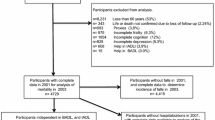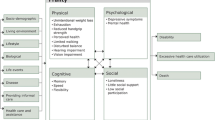Abstract
Objective
To explore the association of frailty according to questionnaire data (modified Fried criteria) with important endpoints in older men.
Design and setting
Prospective cohort study (the Helsinki Businessmen Study) in Finland.
Participants and measurements
In 1974, clinically healthy men (born 1919–1934, n=1815) of similar socioeconomic status were identified. After a 26-year follow-up in 2000 (mean age 73 years), disease prevalence, mobility-disability, and frailty status (80.9% of survivors, n=1125) were appraised using a postal questionnaire including RAND-36. Four criteria were used for definition: 1) >5% weight loss from midlife, or body mass index (BMI) <21 kg/m2; 2) reported physical inactivity; 3) low vitality (RAND-36); 4) physical weakness (RAND-36). Responders with 3–4, 1–2, and zero criteria were classified as frail (n=108), prefrail (n=567), and nonfrail (n=450), respectively. Eight-year mortality was assessed from registers, and in 2007, survivors were re-assessed with questionnaires.
Results
Nonfrail as referent and adjusted for age, BMI and smoking, both prefrail (HR 2.26; 95% CI, 1.57–3.26), and frail status (4.09; 95% CI, 2.60–6.44) were significant predictors of mortality. Nonfrailty predicted better survival independently of the frailty components, diseases, and disability, and also predicted faster walking speed and less disability 7 years later.
Conclusions
Frailty, and also prefrailty, as defined using questionnaire data (RAND-36) independently predicted important endpoints in older men.
Similar content being viewed by others
References
Fried LP, Tangen CM, Walston J, et al (2001) Frailty in older adults.: evidence for a phenotype. J Gerontol A Biol Sci Med Sci 56A:M146–M156
Fried LP, Ferrucci L, Darer J, Williamson JD, Anderson G (2004) Untangling the Concepts of Disability, Frailty, and Comorbidity: Implications for Improved Targeting and Care. J Gerontol A Biol Sci Med Sci 59:M255–263.
Bergman H, Ferrucci L, Guralnik J, et al (2007) Frailty: An Emerging Research and Clinical Paradigm-Issues and Controversies. J Gerontol A Biol Sci Med Sci 62: 731–737
Rockwood K, Mitnitski A (2007) Frailty in relation to the accumulation of deficits. J Gerontol A Biol Sci Med Sci 62:722–7.
Abellan van Kan G, Rolland Y, Bergman H, Morley JE, Kritchevsky SB, Vellas B (2008) The I.A.N.A Task Force on frailty assessment of older people in clinical practice. J Nutr Health Aging 12:29–37
Santos-Eggimann B, Cuenoud P, Spagnoli J, et al (2009) Survey of Health, Aging and Retirement in Europe (SHARE) Prevalence of frailty in middle-aged and older community-dwelling Europeans living in 10 countries. J Geront A Biol Sci Med Sci 64:675–81
Karunananthan S Wolfson C, Bergman H, Béland F, Hogan DB (2009) A multidisciplinary systematic literature review on frailty: Overview of the methodology used by the Canadian Initiative on Frailty and Aging. BMC Med Res Method 9:68 doi:10.1186/1471-2288-9-68
Hays RD, Morales LS (2001) The RAND-36 measure of health-related quality of life. Ann Med;33:350–7.
McHorney C, Ware JJ, Lu J, Sherbourne C (1994) The MOS 36-item Short-Form Health Survey (SF-36): III. Tests of data quality, scaling assumptions, and reliability across diverse patient groups. Med Care 32:40–66.
Miettinen TA, Huttunen JK, Naukkarinen V, et al (1985) Multifactorial primary prevention of cardiovascular diseases in middle-aged men: risk factor changes, incidence and mortality. JAMA 254:2097–2102
Strandberg TE, Strandberg AY, Salomaa VV, et al (2009) Explaining the obesity paradox: cardiovascular risk, weight change, and mortality during long-term followup in men. Eur Heart J 30:1720–1727.
Aalto A, Aro A, Teperi J. RAND-36 as a measure of Health-Related Quality of Life. Reliability, construct validity and reference values in the Finnish general population. Helsinki: Stakes, Research Reports 101, 1999
Charlson ME, Pompei P, Ales KL, MacKenzie CR (1987) A new method of classifying prognostic comorbidity in longitudinal studies: Development and validation. J Chronic Dis 40:373–83.
Syddall HE, Martin HJ, Harwood RH, Cooper C, Sayer AA (2009) The SF-36: A simple, effective measure of mobility-disability for epidemiological studies. J Nutr Health Aging 13:57–62
Gupta AK, Dahlof B, Sever PS, et al (2010) Metabolic syndrome, independent of its components, is a risk factor for stroke and death, but not for coronaRy heart disease among hypertensive patients in the ASCOT-BPLA. Diabetes Care 33:1647–1651
Gill TM, Gahbauer EA, Allore HG, Han L (2006) Transitions between frailty states among community-living older persons. Arch Intern Med 166:418–423
Rochat S, Cumming RG, Blyth F, et al (2010) Frailty and use of health and community services by community-dwelling older men: the Concord Health and Ageing in Men Project. Age Ageing, ePub
Abellan van Kan G, Rolland Y, Andrieu S, et al (2009) Gait speed at usual pace as a predictor of adverse outcomes in community-dwelling older people. An International Academy on Nutrition and Aging (IANA) Task Force. J Nutr Health Aging 13:881–889
Hubbard R, Searle S, Mitnitski A, Rockwood K (2009) Effect of smoking on the accumulation of deficits, frailty and survival in older adults: A secondary analysis from the Canadian study of health and aging. J Nutr Health Aging;13:468–472.
Dumurgier J, Elbaz A, Ducimetiere P, Tavernier B, Alperovitch A, Tzourio C (2009) Slow walking speed and cardiovascular death in well functioning older adults: prospective cohort study. Br Med J;339:b4460 ePub
Gill TM, Gahbauer EA, Han L, Allore HG (2010) Trajectories of disability in the last year of life. N Engl J Med 362:1173–1180
Rockwood K, Howlett SE, MacKnight C, et al (2004). Prevalence, attributes, and outcomes of fitness and frailty in community-dwelling older adults: report from the Canadian study of health and aging. J Gerontol A Biol Sci Med Sci 59:1310–1317
Avila-Funes JA, Amieva H, Barberger-Gateau P, et al (2009) cognitive impairment improves thepredictive validity of the phenotype of frailty for adverse health outcomes: the three-city study. J Am Geriatr Soc 57:453–461
Boyle PA, Buchman AS, Wilson RS, Leurgans SE, Bennett DA (2010) Physical frailty is associated with incident mild cognitive impairment in community-based older persons. J Am Geriatr Soc 58:248–255
Raji MA, al Snih S, Ostir GV, Markides KS, Ottenbacher KJ (2010) Cognitive status and future risk of frailty in older Mexican Americans. J Geront A Biol Med Sci 65A:1228–1234
Parker SG, Bechinger-English D, Jagger C, Spiers N, Lindesay J (2006) Factors affecting completion of the SF-36 in older people. Age Ageing 35:376–381.
Bergmann MM, Jacobs EJ, Hoffmann K, Boeing H (2004) Agreement of selfreported medical history: comparison of an in-person interview with a selfadministered questionnaire. Eur J Epidemiol 19:411–416.
Tamakoshi K, Yatsuya H, Kondo T, et al (2003) The accuracy of long-term recall of past body weight in Japanese adult men. Int J Obes Relat Metab Disord 27:247–252
Miller SL, Wolfe RR (2008) The danger of weight loss in the elderly. J Nutr Health Aging. 12(7):487–491
Author information
Authors and Affiliations
Corresponding author
Rights and permissions
About this article
Cite this article
Sirola, J., Pitkala, K.H., Tilvis, R.S. et al. Definition of frailty in older men according to questionnaire data (RAND-36/SF-36): The Helsinki Businessmen study. J Nutr Health Aging 15, 783–787 (2011). https://doi.org/10.1007/s12603-011-0131-4
Received:
Accepted:
Published:
Issue Date:
DOI: https://doi.org/10.1007/s12603-011-0131-4




